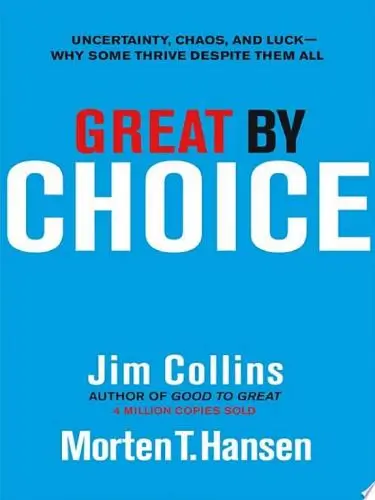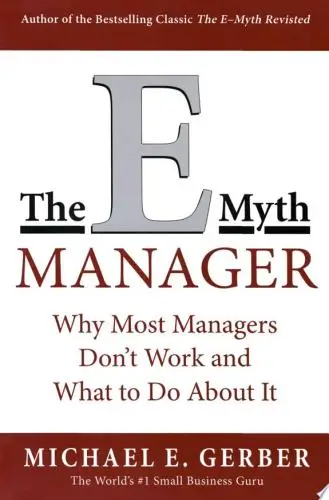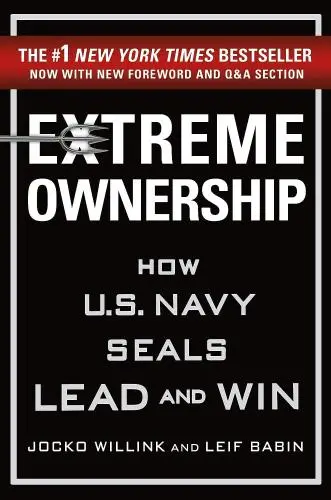Extreme Ownership
How U.S. Navy Seals Lead and Win
What's it about?
Extreme Ownership by Jocko Willink is a compelling guide to leadership, drawing on the author's experiences as a Navy SEAL. Willink emphasizes the concept of extreme ownership, where leaders take full responsibility for their team's successes and failures. He provides practical advice and real-life examples to help readers apply these principles in their own lives. This book is a must-read for anyone looking to improve their leadership skills and take control of their own success.
About the Author
Jocko Willink is a former Navy SEAL commander, author, and podcaster known for his no-nonsense approach to leadership and personal development. His book "Extreme Ownership" emphasizes taking responsibility for one's actions and decisions, a theme that permeates his work. Willink's writing style is direct and practical, offering actionable advice for individuals looking to improve their lives and become better leaders. His unique perspective as a military leader provides valuable insights for both personal and professional growth.
11 Key Ideas of Extreme Ownership
- No Bad Teams, Only Bad Leaders
- Believe
- Check the Ego
- Cover and Move
- Simple
- Prioritize and Execute
- Decentralized Command
- Plan
- Leading Up and Down the Chain of Command
- Decisiveness amid Uncertainty
- Discipline Equals Freedom—The Dichotomy of Leadership
At the heart of every high-performing team is a leader who understands that their role goes beyond mere management. It's about embodying the principle that there are no bad teams, only bad leaders. This profound idea stems from real-world experiences where leadership has proven to be the linchpin in transforming struggling groups into cohesive units capable of achieving remarkable feats.
The story shared by a Navy SEAL instructor during Hell Week at BUD/S serves as a powerful testament to this truth. A simple change in leadership caused an underperforming boat crew to rise from last place to first, illustrating how effective guidance can unleash a team's potential. This narrative isn't just about military prowess; it encapsulates a universal lesson applicable across all walks of life: leadership is not just influential—it's transformative.
Leaders who embrace Extreme Ownership do more than direct; they inspire and elevate those around them, creating an environment where success is not just hoped for but expected and worked towards collectively.
Unpacking Leadership Dynamics
- Leadership Drives Performance: The caliber of leadership directly correlates with team performance.
- Extreme Ownership: Leaders must fully own every aspect of their team’s operation and its outcomes—both triumphs and setbacks.
- Culture Transformation: A shift in leadership approach can revitalize an underperforming group, fostering resilience and excellence.
- Continuous Improvement: True leaders never settle—they constantly seek ways to enhance both personal skills and team capabilities.
- Effective Leadership Is Contagious: When one leader demonstrates Extreme Ownership, it sets off a ripple effect, encouraging others within the organization or community to follow suit.
Tactics
- Embrace Extreme Ownership: Create an organizational culture where ownership extends beyond individual tasks—where each person feels responsible for collective achievements as well as failures. Empowerment coupled with accountability becomes the norm rather than exception.
- Set High Standards & Enforce Them: Clarity on expectations paired with unwavering enforcement ensures everyone knows what excellence looks like and understands that nothing less will suffice.
- Lead by Example: Showcase qualities such as resilience, determination, adaptability under pressure etc., setting an example for others on how they should conduct themselves professionally.
- Encourage Continuous Improvement & Adaptation: Invest in your people through training sessions or workshops aimed at skill enhancement or mastery—a commitment to growth signals dedication toward continuous improvement.
- Cultivate Teamwork & Collaboration: Foster trust through collaborative projects with defined roles yet unified goals—teamwork becomes second nature when collaboration is ingrained within operations.
- Provide Constructive Feedback: Balance critiques with praise by offering feedback that acknowledges strengths while also pinpointing areas ripe for development—a dual approach encourages progress without dampening morale.
- Develop Junior Leaders: Spotlight emerging talent ready for greater responsibility ensuring your organization remains robust even when key players are absent—an investment in future leaders safeguards continuity and stability.
In essence, good leadership transcends titles—it’s about influence, responsibility, vision casting, relentless pursuit of excellence—and most importantly—the understanding that true strength lies not solely within oneself but within one’s ability to uplift others along the journey towards common objectives.
Key Examples/Data
- Hell Week in SEAL Training: During Hell Week of SEAL training, students faced extreme physical and mental challenges, with nearly two hundred determined young men starting the training, but most quitting within the first forty-eight hours. The training was not just a fitness test, but a mental challenge, where success resulted from determination, innovation, and communication with the team. The best athletes didn't always make it through Hell Week, emphasizing the mental aspect of the training.
- Boat Crew Leadership in BUD/S Training: The BUD/S students were grouped into teams called "boat crews," with each crew led by a senior-ranking member responsible for the crew's performance. During Hell Week, boat crews competed in races, with the winning crew earning a few minutes of rest while the losing crew faced additional punishing exercises. The boat crew leader's attitude set the tone for the entire team, and their leadership was the single greatest factor in the crew's performance.
- Transformation of Boat Crew VI: Boat Crew VI consistently performed poorly, with members operating as individuals and blaming each other for their failures. The boat crew leader was indifferent, feeling that no effort could change their poor performance. However, when the leaders of Boat Crew II and Boat Crew VI swapped positions, Boat Crew VI, under new leadership, went from the worst-performing crew to the best, demonstrating the significant impact of leadership on team performance.
- Combat Leadership and Loss: The author reflected on his experience as a SEAL platoon commander in Ramadi, Iraq, where he faced immense pressure and made life-and-death decisions. He shared the devastating loss of fellow SEALs in combat, emphasizing the immense burden of command and the responsibility of leaders for their teams' lives and performance.
- Application to Business: The author worked with a financial services company where the concept of Extreme Ownership was met with resistance by a key leader, the chief technology officer (CTO). Despite the CEO's initial reluctance to let the CTO go, the author emphasized the importance of driving leaders to exercise Extreme Ownership and holding them accountable for their team's performance. Eventually, the CTO was replaced, and the company rebounded, illustrating the impact of effective leadership on team performance and success.
Quotes
- "There are no bad teams, only bad leaders."
- "When leaders who epitomize Extreme Ownership drive their teams to achieve a higher standard of performance, they must recognize that when it comes to standards, as a leader, it’s not what you preach, it’s what you tolerate."
- "The leader’s attitude sets the tone for the entire team. The leader drives performance—or doesn’t."
- "There are only two types of leaders: effective and ineffective. Effective leaders that lead successful, high-performance teams exhibit Extreme Ownership. Anything else is simply ineffective. Anything else is bad leadership."
- "Leaders must accept total responsibility, own problems that inhibit performance, and develop solutions to those problems."
- "Whether in SEAL training, in combat on distant battlefields, in business, or in life: there are no bad teams, only bad leaders."
Extreme Ownership Summary: Common Questions
Experience Personalized Book Summaries, Today!
Discover a new way to gain knowledge, and save time.
Sign up for our 7-day trial now.
No Credit Card Needed

Similar Books

Emotional Intelligence at Work
Dalip Singh
Seeing the Big Picture
Kevin Cope
Leadership Is Concept Heavy
Dr. Enoch Antwi
Great by Choice
Jim Collins
The Leader′s Guide to Coaching in Schools
John Campbell
Preparing School Leaders for the 21st Century
Stephan Gerhard Huber
The E-Myth Manager
Michael E. Gerber
Leadership Is Language
L. David Marquet
Start-up Nation
Dan Senor
The Founder's Dilemmas
Noam WassermanTrending Summaries

Peak
Anders Ericsson
Never Split the Difference
Chris Voss
Smart Brevity
Jim VandeHei
The Psychology of Money
Morgan Housel
The First 90 Days
Michael D. Watkins
Atomic Habits
James Clear
Thinking, Fast and Slow
Daniel Kahneman
The Body Keeps the Score
Bessel van der Kolk M.D.
The Power of Regret
Daniel H. Pink
The Compound Effect
Darren HardyNew Books

Job Interviews For Dummies®
Joyce Lain Kennedy
Job Interviews In A Week
Alison Straw
Handbook of Career Development
Gideon Arulmani
The Art of Spending Money
Morgan Housel
$100M Offers
Alex Hormozi
A Candle for Kiri
Edna Mae Holm
Principles of Marketing, Global Edition
Gary Armstrong
Serpent Rising: The Kundalini Compendium
Neven Paar
Feeling Is the Secret
Neville Goddard

